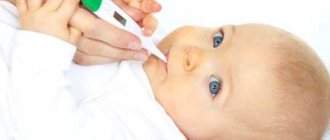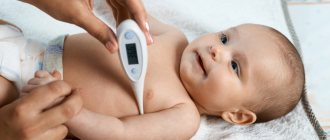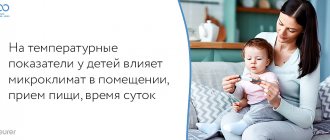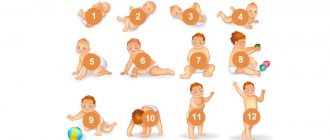home
Articles
Health
Kurilova Alina Petrovna
Pediatrician
14.05.2019
Before you start taking antipyretics, you need to answer a few questions:
- what age is the child?
- How does a child tolerate an increase in temperature?
- Is there a family or child history of febrile seizures?
- Are there any other symptoms of the disease besides fever?
Increased temperature or fever
is a protective-adaptive reaction of the body in response to the influence of pathogenic stimuli, as a result of which a restructuring of thermoregulation processes occurs, leading to an increase in body temperature, which stimulates the natural resistance of the body.
An increase in temperature affects the child’s body both positively and negatively.
Positive influence
is that when the temperature rises in the child’s body, the immune system is activated, phagocytosis increases, the production of antibodies increases and the level of interferon increases, which helps to stop the proliferation of pathogenic microorganisms and overcome infection.
Bad influence
high temperature on a child manifests itself in the occurrence of convulsions (febrile), increased load on the baby’s cardiopulmonary system (heart rate and breathing rate increase). Therefore, fever is dangerous for children with developmental defects of the heart and bronchopulmonary system, and heart rhythm disturbances. Also, when the temperature rises, the functioning of the brain, liver, stomach, kidneys and other internal organs suffers, which is dangerous for children with chronic pathologies of internal organs, symptoms of dehydration, developmental disorders and diseases of the nervous system.
The main reasons for a temperature of 40 °C
The most common cause of an increase in body temperature to 40 degrees is acute respiratory viral infections1,4. They are also accompanied by cold symptoms: runny nose with liquid mucous discharge and/or impaired nasal breathing, sore throat, discomfort and sometimes sore throat. Possible hoarseness, cough, and congestion in the ears. This condition can occur almost simultaneously with a rise in temperature to 40 degrees or some time later - this happens, for example, with the flu. Fever in such respiratory infections is a sign of an active fight of the immune system against the invading pathogen1,2,4.
An increase in temperature below 40 °C during viral diseases is also due to the addition of a secondary bacterial infection. This can lead to the development of complications such as tracheobronchitis, pneumonia, sinusitis, otitis media, tonsillitis (tonsillitis)2.
Up to contents
What is the danger of a temperature of 40 ° C?
A temperature of 40 degrees is a very dangerous symptom. Such severe fever is accompanied by increasing general dehydration, negatively affects the functioning of all internal organs and leads to severe overload of the cardiovascular system. The consequence of such stress for the body can be acute heart failure and other conditions (especially in elderly patients)1.
A temperature of 40 degrees can also provoke swelling of the nervous tissue with subsequent cerebral edema1. Symptoms of this process are a variety of neurological disorders and depression of consciousness1. Sometimes with such a fever, hallucinations appear and the patient begins to delirium.
In a child, a temperature of 40 °C can lead to seizures3,4,5. This is what makes it especially dangerous for children with neurological disorders.
Up to contents
Why is high temperature dangerous?
Sometimes an increase in temperature (more than 40 degrees) is dangerous for a child. This condition can harm the body and provoke all sorts of complications, since it is accompanied by an accelerated metabolism. The need for oxygen also increases, and fluid is eliminated faster. This is fraught with negative consequences at an early age. This temperature is dangerous for children.
The most common complication in childhood is the appearance of febrile seizures and dehydration.
When should you call an ambulance?
At such a high temperature you should always call an ambulance. This should be done as soon as one or more of the following symptoms appear:
- excessive drowsiness, obvious lethargy, disorientation;
- hallucinations, delusions;
- severe shortness of breath, chest pain, blue discoloration of the nasolabial triangle, heart rhythm disturbances;
- stomach ache;
- increasing dehydration, which is indicated by a decrease in skin moisture, dry tongue and sclera, a significant decrease in the amount of urine;
- rash;
- lack of effect from taking antipyretics, maintaining the temperature at 40 ° C or even increasing it3,4,5.
It is also recommended to call an ambulance if a fever develops in a child with neurological diseases. Emergency consultation with a doctor is also necessary for patients with immunodeficiency and elderly patients.
Up to contents
What not to do at a temperature of 40
At high temperatures, a mandatory consultation with a doctor is required; any self-medication is dangerous, but there are a number of situations when the help of a specialist is required immediately.
When you need to see a doctor urgently:
- high fever lasts three days;
- at high temperatures, a rash appears, intense headache, vomiting, diarrhea with impurities, wheezing is heard in the throat, and breathing problems arise;
- convulsions and spasms appear against the background of temperature;
- the child has a history of cerebral palsy, epilepsy and other neurological pathologies, chronic heart disease;
- the skin becomes pale, bluish, such a sign is a reason to call a doctor already at a temperature of 37.5 degrees;
- antipyretic drugs do not work, the temperature does not go down within 30–40 minutes after taking the medicine.
At a high temperature, you should not wrap the child up, force-feed, or wipe with any alcohol- or vinegar-based solutions - toxic substances penetrate through the pores into the blood, which is dangerous for severe poisoning. In case of hyperthermia, inhalations, mustard plasters, baths and other warming procedures are contraindicated; massage should not be done or antibacterial drugs should be given without a doctor’s prescription. You should refrain from walking until the baby’s condition improves slightly.
A child with a fever can only be wiped with warm water - when hot skin comes into contact with cold, vascular spasm occurs and heat transfer is impaired. Body temperature may drop, but internal organs will begin to overheat.
Important! You should immediately consult a doctor if a temperature above 39 degrees is observed in a child under 3 months.
Is it necessary to lower the temperature to 40°C?
If the temperature has risen to 40 °C, it must be brought down, regardless of the well-being of the sick person and his age3,4,5. However, one should not strive for rapid and complete elimination of fever. To begin with, it will be enough to lower the temperature from 40 to 38–38.4 °C. Only if fever is poorly tolerated, neurological disorders and other complications develop, they try to immediately reduce it to 37–37.5 °C. The fact is that a very sharp decrease in temperature to a normal level can aggravate cardiovascular failure, which inevitably makes itself felt at a temperature of 40 degrees3.
Up to contents
How to bring down a temperature of 40 in a child
Hyperthermia with such indicators is very dangerous for young children. It is necessary to take measures to eliminate it as soon as possible.
As you know, doctors do not recommend giving a child antipyretics for infectious diseases, relying on the work of the immune system.
But this condition applies to thermometer readings up to 38-38.5 degrees. If the thermometer shows 40, then do not hesitate: hurry to give your baby an antipyretic.
A number of medications designed specifically for children will help bring down a child’s temperature above 40:
- suppositories Nurofen and Tsefekon - used in children from 1-2 months (act quickly, do not pass through the gastrointestinal tract);
- syrups Nurofen, Panadol, Efferalgan - used from three months, some also have an anti-inflammatory effect;
- Nimulid suspension - is more effective than previous medications, but its use is only permissible from 12 months;
- Ibuklin Junior tablets are a combined drug based on two active ingredients, approved for use from 3 years of age.
Other means
If a child has a temperature of 40 without symptoms, Dr. Komarovsky (a famous pediatrician) recommends organizing the right conditions first. Parents should follow the rules:
- organize the humidity in the room at 50-65%, and make the temperature from 18 to 23 degrees;
- do not wrap the child up, even if he is shivering;
- give the baby more liquid (water, fruit drinks, compotes, warm teas);
- ventilate regularly without creating drafts;
- do not force him to eat if the baby does not want to;
- arrange bed rest whenever possible.
If you don't have approved antipyretic medications on hand:
- Wiping with clean water (it is unacceptable to use alcohol or vinegar, even in diluted form). Pay special attention to the places where large blood vessels pass: armpits, groin, neck, inner elbow area.
- Compress on the forehead. Dip a clean cloth in water and wring it out lightly. Place the structure on the child’s forehead and change it as it warms up.
- If the baby wears a diaper, then it must be removed, since the diaper is an additional source of heat. By removing it, you can achieve a decrease in temperature by 0.2-0.3 degrees.
- Immersion in water. Pour water into the bath, the temperature of which is 1-1.5 degrees lower than that of the child (if the baby is 40, then the water temperature should be at least 38.5 degrees). Place the sick person in water for 7-10 minutes. In this way you will achieve a smooth decrease in temperature.
What should you do at a temperature of 40 °C?
It is recommended to take age-appropriate medications with antipyretic properties, stay in bed for at least 3-4 days, drink plenty of warm liquids and avoid overheating3,4,5. Do not forget that in most cases such fever is caused by infection. Therefore, it is necessary to take measures to prevent infection of other family members. Relatives of the sick person are advised to ventilate the room, use separate dishes from the sick person, wear masks, wash their hands frequently and carry out wet cleaning.
Up to contents
Temperature 40 °C in a child
A child with a temperature below 40 °C can be a symptom of many diseases4. Moreover, not all of them can be correctly diagnosed during the initial examination. For example, severe kidney and urinary tract infections can mimic the pathology of the digestive system. After all, in a child they are often accompanied by abdominal pain, nausea and vomiting against a background of a temperature of 40 degrees. And the initial stage of measles is very similar to respiratory viral diseases.
Such a high fever must be brought down, even if the child has a temperature of 40 ° C without symptoms of damage to internal organs4,5. He should be given a doctor-approved antipyretic drug, following the recommended age-specific dosage4,5. Preference is usually given to drugs in soluble form or in syrup form, which makes swallowing easier and speeds up the process of absorption of the drug in the digestive tract. In consultation with the pediatrician, it is permissible to use non-drug measures to increase heat transfer from the surface of the skin.
You cannot give your child antibiotics on your own4,5. The decision on this method of treatment can only be made by a doctor if the temperature rises to 40 °C due to a bacterial infection. For viral diseases, antibiotics are simply useless.
The lack of effect from taking antipyretics, signs of depression of the central nervous system, the development of convulsions and symptoms of obvious dehydration in a child are reasons for urgently consulting a doctor and deciding on hospitalization4.
Up to contents
Causes of fever in children without additional symptoms
When body temperature increases in children, the immune system is activated. This kind of protection of the body helps to cope with many harmful bacteria and viruses, destroying them and preventing them from multiplying further. If a child has a temperature of 40 without symptoms, the reasons may be the following:
- a viral disease, more often the flu (the body tries to cope in this way, preventing additional signs of the disease from appearing);
- sunstroke (occurs in children during prolonged exposure to the open sun, usually does not have additional obvious signs);
- infectious diseases of children (rubella, roseola, chickenpox) - begin with asymptomatic hyperthermia, after which a rash appears;
- the appearance of new teeth (in some children it goes unnoticed, while in others it is accompanied by hyperthermia, which is a consequence of the inflammatory process in the gums;
- stomatitis almost always occurs with a high temperature (parents may simply not notice additional signs in the form of mouth ulcers);
- inflammatory processes of the urinary system (pyelonephritis, cystitis, bacteriuria) - manifested by fever without additional external symptoms.
Many diseases in children proceed completely differently from those in adults. A child encounters most viruses for the first time, and an adult already has antibodies against them. Also, some infections only affect children under 5 years of age. If the child is very young (up to 1-2 years), then he simply cannot complain about additional symptoms of the disease that the parent does not notice.
Reasons for a temperature of 40 °C without cold symptoms
The cause of a temperature of 40 °C can be not only acute respiratory diseases and their complications. Such severe fever can be caused by:
- severe intestinal infections of viral or bacterial origin;
- a focus of purulent infection in peripheral soft tissues, chest or abdominal cavity, internal organs;
- sepsis;
- meningitis;
- pneumonia;
- consequences of toxic, ischemic or traumatic damage to the deep structures of the brain, accompanied by disruption of the functioning of the thermoregulation center;
- malaria (testing for this disease is mandatory for repeated episodes of a sharp increase in temperature up to 40 ° C with chills).1,2,4,5
There are many diseases that can occur with severe fever. And only a doctor can diagnose them. Therefore, if the temperature rises to 40 °C, you should not self-medicate; you should consult a specialist.
Up to contents
RINZA® and RINZASIP® with vitamin C at a temperature of 40 °C
Treatment at a temperature of 40 degrees includes etiotropic (aimed at eliminating the cause) and symptomatic (to reduce the severity of symptoms) therapy. And drugs with antipyretic effects play a key role. At the same time, according to the recommendations of the WHO (World Health Organization), preference should be given to drugs based on paracetamol4.
RINZA® tablets and powder for preparing an oral solution RINZASIP® with vitamin C are modern products that can be used as symptomatic therapy for acute respiratory diseases with fever in adults and adolescents over 15 years of age, as well as for children over 6 years of age (for drug RINZASIP® for children)6,7,8. They have an antipyretic effect, help relieve headaches, muscle pain and sore throat, and also reduce nasal congestion and swelling6,7,8.
Up to contents
The information in this article is for reference only and does not replace professional advice from a doctor. To make a diagnosis and prescribe treatment, consult a qualified specialist.
Literature:
- Maltseva L.A. Pyrexia and antipyretic therapy in patients with critical conditions. // Maltseva L.A., Mosentsev N.F. / Emergency Medicine, No. 4 (91), 2021, p. 51-56.
- A.N. Smirnov. Differential diagnosis of hyperthermia in non-infectious pathology. Part 2. / A.N. Smirnov, E.P. Pogorelskaya // Archives of Internal Medicine. No. 6(14), 2013; With. 53-58.
- L.I. Kalyuzhnaya. Heat disturbances and fever. / L.I. Kalyuzhnaya, D. A. Zemlyanoy // Pediatrician volume VI No. 1 2015, p. 124-133.
- Yu. B. Belan. Fever in pediatric practice. / Yu. B. Belan, M. V. Starikovich // Attending physician. No. 10/13, 2013.
- Delyagin V. M. Fever. The variety of reasons and the complexity of the solution / To help the pediatrician. No. 1 2013, p. 80-83.
- Instructions for use of the drug RINZA®. Registration number: P N015798/01.
- Instructions for use of the drug RINZASip® with VITAMIN C. Registration number: LS-002579.
- Instructions for use of the drug RINZA® for children. Registration number: LP-001821.










